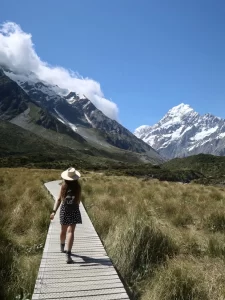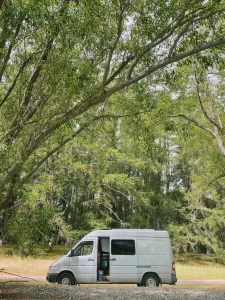True or false: planning a trip is enjoyable, fun, and easy to do? If you answered false, listen up — there is a way to make it less stressful! As someone who loves trip planning (almost as much as the trip itself), I decided to come up with this list to explain how to plan a trip from start to finish. Read on for a step-by-step guide with flight attendant-approved travel tips that will make planning your next trip a breeze!
- Step 1: Decide where you want to travel
- Step 2: Decide when you want to travel
- Step 3: Look into travel restrictions & visa requirements
- Step 4: Book your flights
- Step 5: Book your accommodation
- Step 6: Book your transportation
- Step 7: Start planning your itinerary
- Step 8: Book your excursions, tours, & activities
- Step 9: Book restaurant reservations
- Step 10: Purchase travel insurance
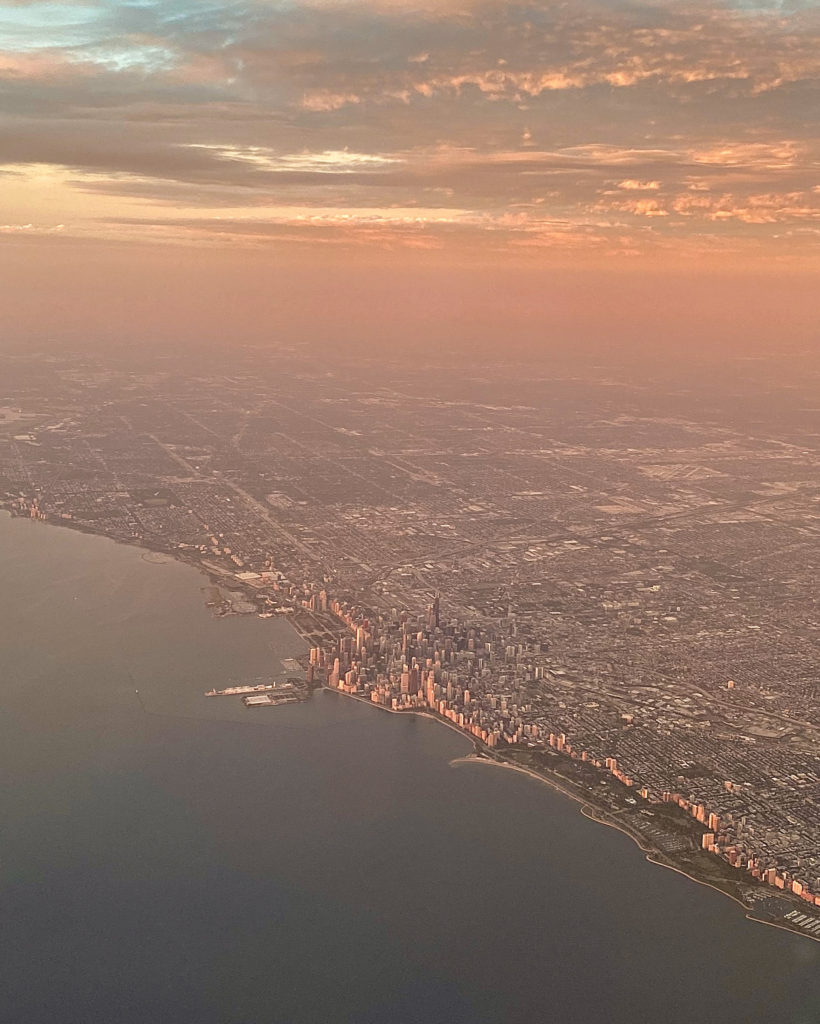
Step 1: Decide where you want to travel
This is seemingly the easiest step, but I actually find it quite difficult! There are so many incredible places on this Earth that it becomes pretty challenging to narrow them down. Here are a few questions I ask myself when deciding where to travel to next:
- How much time do I have? I don’t want to plan a trip somewhere across the globe when I only have a few days.
- What kind of trip do I want to have? Am I looking for a chill, all-inclusive beach vibe? Or do I want to go to museums and explore city streets?
- Who will I be traveling with? When I’m solo, I like to choose a relatively safe and easy place to navigate. With a group of friends, I’ll look for somewhere with good nightlife and restaurants.
- Where have I not been yet? Going to the same destinations over and over again is great for some people, but I usually prefer to go somewhere new.
- What will the weather be like when I want to go? It’s probably best to avoid booking a trip to the tropics during hurricane season. Likewise, you may have certain activities you want to do that are only available at certain times of the year.
Travel inspiration
- Blogs: Like the one you’re reading now! I love reading other people’s blogs because it’s like having a conversation with a friend who’s already been there.
- Girls LOVE Travel: This is a women-only Facebook group with over 1 million members. People post about their trips and share their itineraries and travel photos.
- Instagram: A classic for visually appealing destinations. I like searching for a location I’m interested in and exploring all of the pictures that were taken there.
- Youtube: Travel vlogs are a great way to visualize a spot before you visit. My favorite channels recently are Daneger & Stacey, Fearless & Far, Backpacking Bananas, and ExpLaura.
How to organize your dream destinations
- Google Maps: My holy grail of trip planning. Anytime I hear about an interesting attraction, restaurant, hotel, etc. I make a list on Google Maps for that country. You can then share your lists with other people, save them offline, and refer back to them when you need directions. I find that this is the best way to keep myself and my millions of recommendations organized. After all… if something’s not on Google, does it even really exist?
- Pinterest: Pinterest is great because most of the travel pins you’ll see link back to a travel blog. You can organize your boards and sections by destination or type of travel (or any other way you’d like!).

Step 2: Decide when you want to travel
Sometimes, this will obviously be dependent on when you are able to get time off. If you have some flexibility, however, here are some questions to consider before deciding:
- Are there any events I want to be there for? If you want to see the Christmas markets in Germany, for example, you’ll have to schedule your trip for December.
- What kind of weather can I tolerate? Because booking a hiking trip to Arizona in July does not sound enjoyable.
- Do I want to book during the shoulder seasons to save money? Usually, you can score lower prices on flights and accommodation if you book your trip over the slower months. The downside is that the weather may not be as pleasant and fewer things could be open.
For me, steps 1 and 2 (the where and the when) are often swapped. I’ll look at my schedule for the next month and choose a destination based on how many days off I have in a row. This can be a good way to go about it if you know that you want to go somewhere but don’t have a specific place in mind.
Step 3: Look into travel restrictions & visa requirements
Nowadays, this can be one of the most difficult parts of knowing how to plan a trip. With border closures and travel restrictions changing (literally) daily, it’s always best to consult the official travel website of the country you’d like to visit. They’ll have the most up-to-date information and instructions on what you need to do before you go. Here are some general tips to keep in mind:
- Some countries around the world are completely open without entry restrictions. Others may require some or all of these:
- A negative COVID test before and/or after arrival
- Proof of recovery from COVID and/or positive antibody test
- Daily health check-ins via text or email
- Contact tracing via app download
- Proof of vaccination
- Self-isolation or quarantine (at home or at a government-approved facility)
- Make sure that any bookings you make are fully refundable and/or changeable. With so much uncertainty right now, it’s important that you can change your plans easily if you need to.
- If you’re vaccinated, make a copy of your vaccination card in case you lose the original. I also like to scan any important documents with the Notes app scanner on my phone.
- Before traveling anywhere, make sure that you’re familiar with your destination’s mask and curfew regulations. You should always respect their rules and cultural norms.
⇉ Is pandemic travel irresponsible? My opinion on travel shaming
Visa requirements
For better or for worse, the nationality on your passport determines where you’re able to travel freely. The number of countries you’re allowed to travel to without a visa is called your passport’s mobility score. Always double-check the visa requirements of the country you’re traveling to before getting on your flight.
Generally, there are three different categories a country may fall into:
- No visa required: You’re free to enter without any visa requirements.
- Visa on arrival: This can either be free or paid on arrival. Make sure you have enough money in the local currency to pay for any visa you might need.
- Visa required: This is the type of visa you need to apply for online before your trip starts.
⇉ How to Get a New Zealand Critical Purpose Visitor Visa
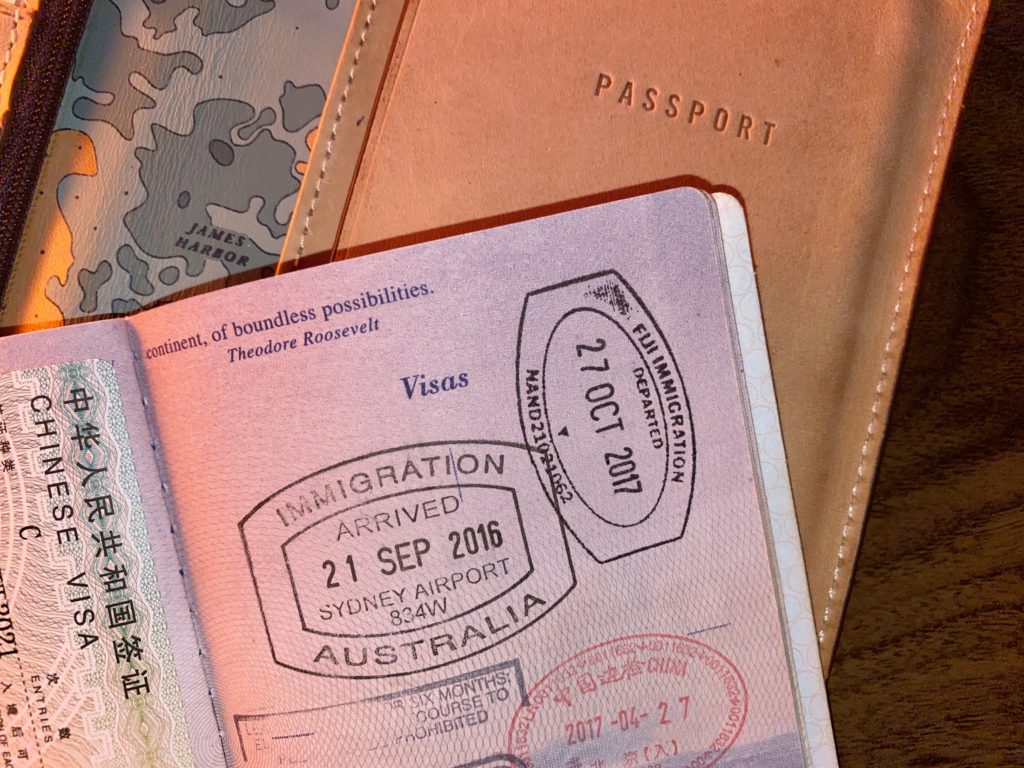
Step 4: Book your flights
If you’re not driving to your destination, you’ll probably need to book flights to get there (unless you live somewhere where trains are a thing — lucky you!). Here are some questions to mull over when choosing flights:
- Do I want the most comfortable flight or will I settle for the cheapest option? I would personally never pay extra to be comfortable on a flight. Give me that long overnight layover and middle seat in the back of the plane for $10, hell yeah! (I love you Ryanair.) I know most people would probably disagree with me here, and that’s fine — choose whatever feels right for you.
- Do I want to arrive in the morning or in the evening? Unless I’m paying for early check-in at my accommodation, I usually try to arrive at my destination in the early afternoon.
- Am I loyal to a certain airline? If you fly with one airline or alliance religiously (or have their credit card), it pays to book with them. You’ll usually get some sort of benefits, like free checked bags or priority boarding.
- Do I have miles to use? Travel hacking is a massive topic in and of itself. If you’ve earned a lot of miles with a certain airline, that could influence the routes or dates you choose to fly.
Best websites to book flights
- Skyscanner
- Kiwi.com
- Directly from the airline — this can sometimes be cheaper than a third-party website!
Flight booking tips
- If you’ve searched for how to plan a trip before, you’ve probably come across this tip already — but that’s because it works! Make sure your browser is in incognito mode when searching for flights. Websites use your cookies, or browsing data, to affect the prices you see. Incognito mode makes sure that your cookies aren’t being stored and used against you later.
- Use a VPN set to a different country. If you’re booking a roundtrip flight from the USA to Canada, for example, try setting your VPN to somewhere in Canada. For some reason, this is often cheaper than booking without a VPN.
- Check out Skyscanner’s article on the best times to book a flight.
Step 5: Book your accommodation
There are so many different types of accommodation to fit any style of traveler. Whether you want something bougie, something instagrammable, or simply a place to rest your head at night, choosing between all the available options can be difficult. Here are some questions I ask myself before booking a place to stay:
- Do I want privacy or do I want to be social? This helps me decide whether I want private or shared accommodation.
- Am I looking for something unique or different? Glamping, treehouses, and cabins in the woods all fall under this category. If I’m in a particularly special place, sometimes I like to get a funky Airbnb to go with it.
- What amenities do I absolutely need? If I’m somewhere hot, this includes a pool. Somewhere cold, maybe an outdoor hot tub. Think about the amenities you value in your own home — a dishwasher, a large bed, a washing machine, etc.
- Will I be doing a lot of cooking or will I be eating out? This helps me decide if I need a place with a kitchen.
Best websites to book accommodation
- Airbnb and VRBO for whole houses/apartments and unique accommodation
- Booking.com for classic hotels
- Hostelworld for hostels
- Directly from the hotel
If you’re a flight attendant or pilot, you can also choose to book through one of our many industry discount pages. Ones I use frequently include Staff Travel Voyage and ID90.
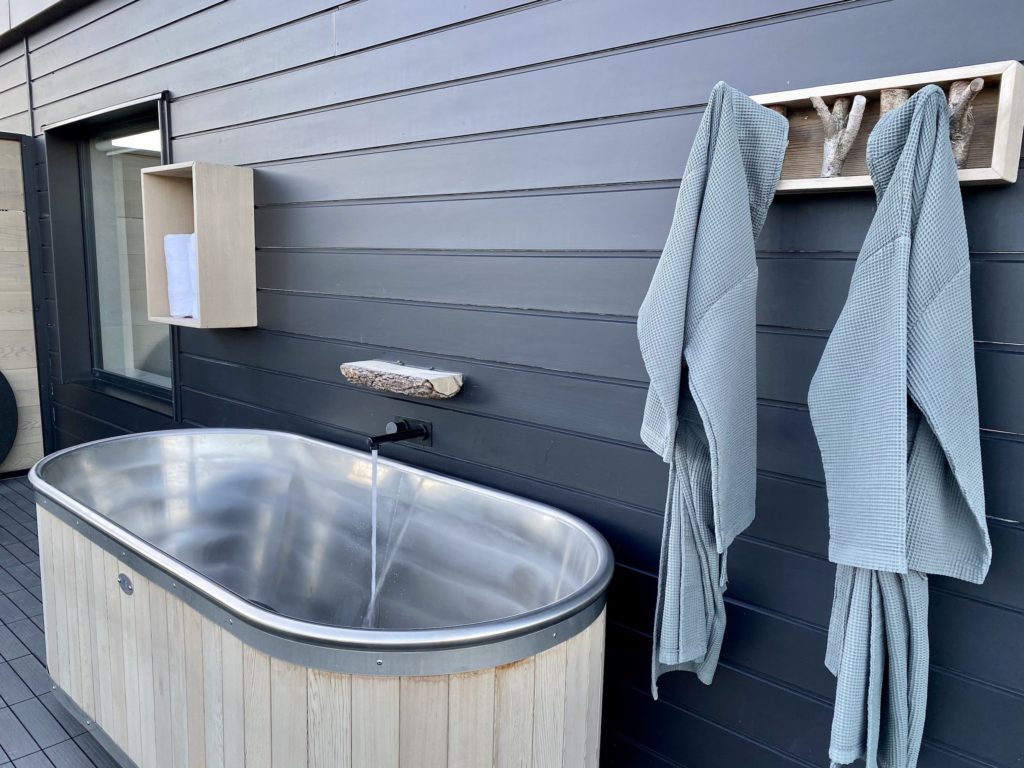
Step 6: Book your transportation
The type of transportation I book for a trip depends on what kind of trip I want to have. Here’s what I would do based on where I plan to go:
- Staying in one city: I’d use public transportation, walk, or pay for Ubers.
- Going to multiple cities/backpacking: I’d use buses, trains, or flights if they’re readily available. Otherwise, I’d rent a car.
- Anywhere without reliable public transportation/off the beaten track: I’d rent a car.
- Exploring National Parks/going on a road trip: I’d rent a car or campervan.
- Staying at a resort: I’d book transfers to and from the airport.
Best places to book transportation
- Kayak for car rentals
- Escape Campervans (USA) and Britz or Jucy (New Zealand) for campervan rentals
- Sixt and Hoppa for airport transfers
⇉ How to plan the perfect New Zealand road trip
Step 7: Start planning your itinerary
Here comes the really fun part! Planning a trip itinerary is both an art and a science — you want to make sure you fit in everything you want to do while leaving yourself enough time to rest and explore. Here are some tips on how to plan a trip that’s balanced and manageable:
- Don’t underestimate travel time: Driving and public transit times can vary wildly from one place to the next. Winding or gravel roads, low speed limits, and traffic can all slow you down considerably. Even two points that look close together on the map can take a long time to get between because they’re separated by mountains! I like to map out my route on Google Maps while planning my trip to make sure that my estimates are realistic.
- Don’t overestimate your physical ability: On the flip side, it’s important to be aware of your own limitations as well. Scheduling a full day of sightseeing might sound good in theory, but it can also be exhausting. Factoring in jetlag, culture shock, and lots of food and drinks makes it possible that you won’t accomplish as much as you think you will. Be sure to schedule some relaxation time into your day.
How to plan a trip while staying organized
- Notion: Notion is my newest organizational obsession. It’s basically like a cuter, more functional version of Google Docs. You can make lists, spreadsheets, tables, calendars, and so much more — it’s extremely powerful. I’m a visual person, so I like making interactive schedules with pictures to plan out my trips. If you share your pages with other people, they can also contribute and make changes.
- My.flightradar24: This is my favorite way to keep track of what flights I’ve been on. You enter your flight number, date, and any relevant details. The website then puts all of your trips on a map and gives you fun statistics.
- Whenever I get a confirmation email, I screenshot it and add it to a trip folder in my photos. That way, I have everything I need in one place and I don’t have to dig for it.
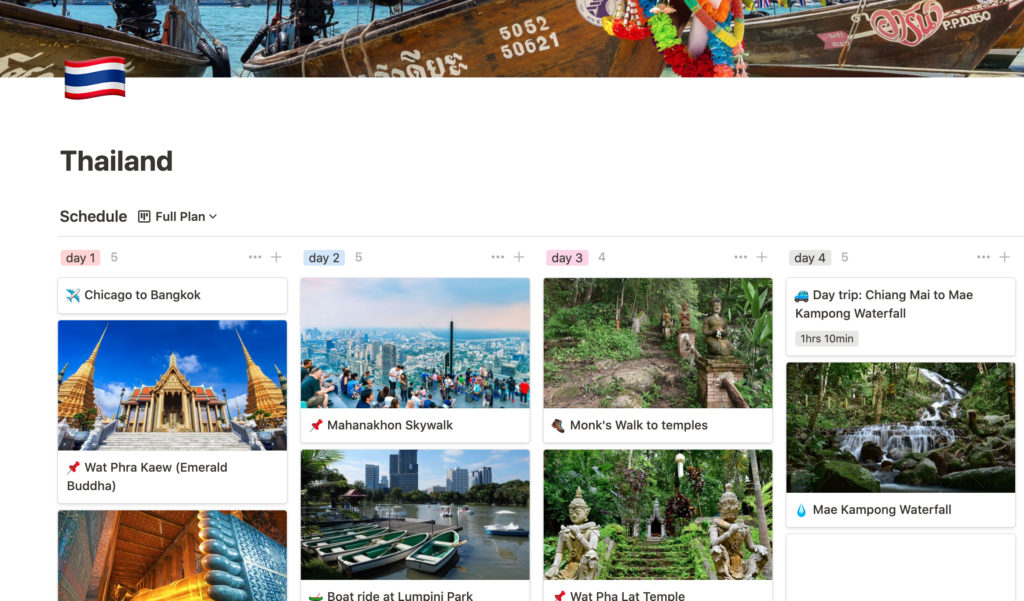
Step 8: Book your excursions, tours, & activities
Once you’ve started planning out your itinerary, you should have a general idea of whether or not you’ll want to book any excursions or tours. Depending on where you’re going, some of these things can be booked last minute. If you know you’ll be somewhere on a certain date or think the event will sell out, it can be comforting to book in advance. Here are some ideas of things to think about booking:
- Multi-day group tours or retreats
- Single-day group tours
- Walking tours
- Boat tours/day cruises
- Personal tour guides/drivers
- Event tickets: concerts, plays, operas, museums, sports games, etc.
- Cooking classes
Step 9: Book restaurant reservations
This might seem a bit extra, but sometimes booking a restaurant reservation in advance is necessary. Generally, you should book ahead for places that are really fancy, are Michelin-starred, or are extremely popular. This goes double if it’s a holiday or long weekend.
You can search for restaurants and make reservations on OpenTable or Tock.
Step 10: Purchase travel insurance
One of the most boring but necessary parts of trip planning. Good travel insurance will cover unfortunate events like illness, injury, emergency evacuations, lost or stolen luggage, and canceled flights. Nowadays, it’s extra important to make sure you have coverage for any unexpected travel interruptions.
World Nomads is highly regarded as one of the best companies for travel insurance.
Thanks for reading this guide on how to plan a trip! Look out for more travel tip posts coming soon.
xoxo Niki

